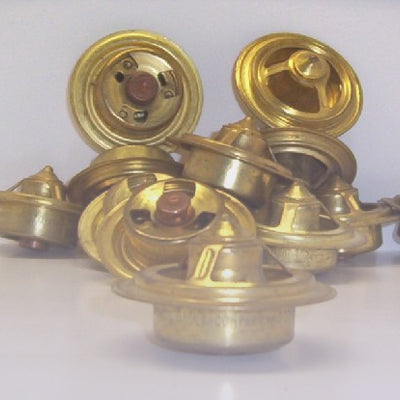Why Robertshaw?

- Until the engine warms up, the coolant is too cool to melt the wax in the balanced thermostat's PowerPill,® a tiny piston that opens the thermostat. With no open passage to the radiator, the coolant re-circulates through the engine.
- The unique three-port construction of the balanced thermostat equalizes the pressure above and below the thermostat's moving valve. Since the coolant exerts equal, yet opposite pressure on the sleeve, the thermostat is "balanced" -- it responds to temperature changes only.
- When the coolant is sufficiently heated to melt the wax in the Power Pill, the wax expands, forcing out the piston and opening the thermostat. The coolant can then circulate through the radiator.
- Fast temperature response increases coolant flow to the radiator, unaffected by pump pressure surges on back side of opening. We recommend and sell Robertshaw thermostats Back in 1916, Robertshaw made the first thermostat for the first American cars. And today, Robertshaw is still first, giving you this exclusive combination of quality features:

Quality features of the Robertshaw Thermostats design:
Stress-free construction. Robertshaw makes the thermostat's strut assembly from brass, not stainless steel, because brass can be bradded to the housing with heat instead of sledge hammer-like stress. This technique permits two brads per strut. Other manufacturers forcefully attach the struts to the housing with intense, metal-weakening pressure on the struts, binding each strut in only one spot.
The Power Pill®. This is the heart of a Robertshaw thermostat. It detects minute changes in the temperature of the coolant, and quickly activates a precision-engineered stem or piston to open and close the thermostat valve.
One-piece bypass poppet. With other thermostats, the bypass valve stem is welded on. The weld tends to fail under stress. To eliminate this problem, Robertshaw manufactures the entire copper cup and bypass stem from a single piece of metal.
Short-stroke piston. In conventional thermostats, the piston must make a large stroke to open the thermostat far enough for adequate coolant flow. But the long stroke compromises durability. Robertshaw engineers achieved a shorter stroke with a uniquely-designed flange and poppet. This design increases the longevity of the thermostat, yet still allows adequate coolant circulation.
Contoured strut. Making the strut assembly from brass instead of steel provides another benefit: brass, being more malleable than steel, can be precisely formed to maximize coolant flow.
Uniform quality. Robertshaw builds all thermostats to OEM standards -- so your replacement thermostat is identical to those used in new Fords, Chryslers, and other cars. Pictured at left is the heart of a Robertshaw thermostat. Its job is to detect minute changes in the temperature of the coolant, and to quickly activate a precision-engineered piston that opens and closes the thermostat valve.
The Robertshaw's Power Pill® Advantage:
Rapid response. The Power Pill's piston is activated by a temperature-sensitive mixture of metallic powder and wax. Some thermostats use an all-wax charge, which responds slowly to temperature changes. Lesser brands mix copper powder with the wax for faster response, but the copper quickly separates from the wax. Robertshaw developed a process to maintain suspension of the copper powder in the wax, so the fast response doesn't deteriorate and the thermostat will not "stick-open" to cause the engine to run cool.
Reliable performance. Most manufacturers use a one-piece rubber diaphragm to seal the charge and drive the piston. If the rubber part ruptures, the thermostat fails. Robertshaw uses two separate parts: a diaphragm to seal the wax, and a stem seat or plug that drives the piston. Rubber material for each part is formulated especially to meet each part's unique requirements. Wear or damage to the stem seat still allows the thermostat to operate satisfactorily.
Precise performance. Every Robertshaw Power Pill is calibrated to bring the thermostat's start-to-open temperature within strict tolerances.


Comments on this post (0)